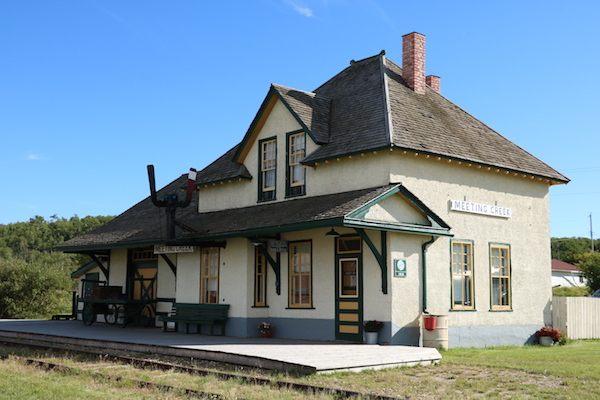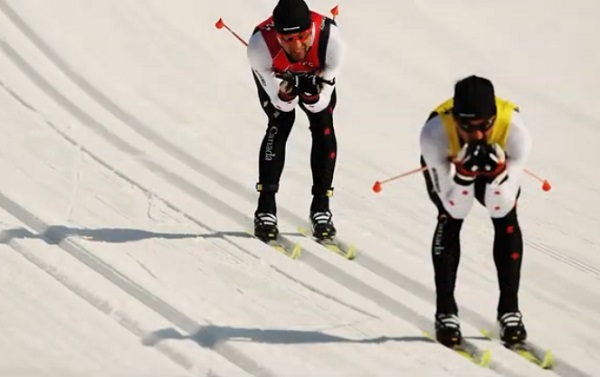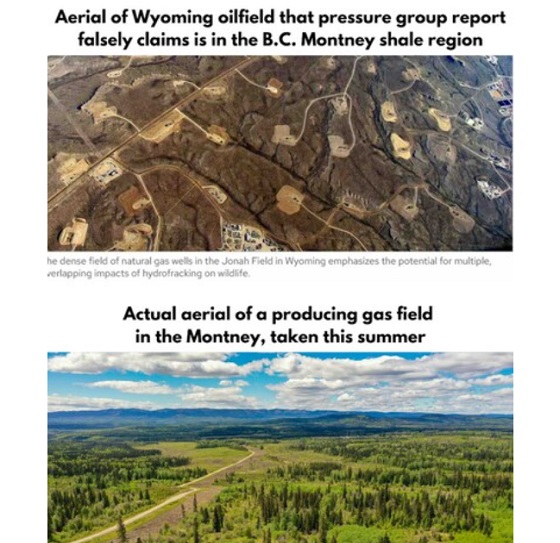Alberta
Summer Vacation Idea – Central Alberta’s collection of Train stations preserved along the Highway 56 Corridor

Article submitted by Paul O’Neil
For decades, the railroad station or “depot” was the transportation hub of many communities across North America. As the “storefront” for the railway company, the depot was the town’s gateway, handling express freight, serving travelers, and providing vital communication in an erathat is now almost forgotten. In Canada’s West, the remaining small-town depots that continue to exist are now museums, private businesses or residences, or in the worst cases have been left to deteriorate as hulks on private property.
There is however a special historical railway on the Prairies that has developed into a true “historic railway district”. A visit to the depots preserved by the Canadian Northern Society in Central Alberta provides a glimpse into the past – an entire collection of classic railroad station designs, carefully and lovingly maintained by a dedicated group of volunteers.

History Background:
Members of the Canadian Northern Society include historians, community volunteers, gardeners, and other local supporters who have since 1987 been active in the preservation of its namesake railway’s history, and in particular its depots. The Canadian Northern Railway (CNoR) traces its origins to Manitoba in 1896. Visionary founders Sir William Mackenzie and Sir Donald Mann – both instrumental as contractors in the completion of the Canadian Pacific Railway – grew the company from a modest short line between Gladstone and the Dauphin district of Manitoba into to a 9500 mile transcontinental system.
Despite the relative business success of the CNoR’s branchline network, negative financial impacts created by the First World War, together with mounting debt from the over-expansion led to the company being nationalized in late 1918. By 1924, operations in Central Alberta were amalgamated with the rival Grand Trunk Pacific Railway under the newly formed Canadian National Railways (CN) banner.
DEPOTS
Similar to other western railroads, the CNoR designed standard plans to be used at individual locations based on the size and importance of the locality to be served. In Alberta, the most common CNoR design was the combination freight and passenger “Third Class” station. Several “Second Class” depots intended primarily for divisional points were constructed, and a single-story “Fourth Class” depot design were also found. The designs were flexible enough that additions could be constructed as traffic or operations warranted. The distinctive pyramid or “semi-pyramid” roofline of a CNoR depot, a feature designed by company architect Ralph Benjamin Pratt, created a unique and pleasing image.
By the late 1960’s the depot-era on the former CNoR Battle River Subdivision (a large portion had by then been renamed the “Stettler Subdivision”) was drawing to a close. However, the presence of a branch line passenger service in the form of a Budd RDC service between Edmonton and Drumheller ensured the continued existence of several depots as passenger shelters that otherwise would most certainly face demolition. The Edmonton to Drumheller service lasted into VIA Rail Canada times until the Trudeau Government service cuts of November 1981 gutted passenger service across Canada.
ENTER THE CANADIAN NORTHERN SOCIETY
Meeting Creek, MP 21.2

My beautiful picture

By 1986, the CNoR Third Class depot at Meeting Creek was surviving on borrowed time, vandalized and yet escaping the fate of several identical structures in neighboring towns. As a result of an interest by a small group of younger railroaders and rail historians, powered perhaps by a few pints enjoyed in a Stettler pub, the Canadian Northern Society (CNoS) was soon established with the intent to save this classic structure from imminent destruction.
Armed with enthusiasm, some grant money, and the support of short-line Central Western Railway; the CNoS got to work repairing the roof, floors, rebuilding the wooden platform, painting, and replacing missing windows, doors and chimneys. By 1989 the Meeting Creek depot was resurrected from a sad state to her today’s 1940’s-era appearance.
Complimenting the station today is another vanishing prairie icon. A 1917 Alberta Pacific Grain elevator located across from the depot was purchased by CNoS from the Alberta Wheat Pool in 1992. Over the years, it too has been conserved by the Society and work continues into its second century. A second grain elevator, while privately owned, ensures that Meeting Creek continues to feature two classic prairie elevators that dominate the skyline in this picturesque location.
Donalda, MP 30.9:

9.7 miles south of Meeting Creek lies the Village of Donalda. Always an agrarian-based community, Donalda was never larger than 500 souls, and as such rated a Canadian Northern Railway “Third Class Depot”. Unfortunately, the original depot at Donalda was demolished in 1984.
Thanks to the efforts of the CNoS, the group was able to relocate an original CNoR “Fourth-Class” type depot, donated by a Saskatchewan farmer many miles to the east. All the Societyhad to do was physically move this building 700 miles from her location at Vandura, Saskatchewan to Donalda! Through fundraising and community support, the building was moved to Donalda in 1991. The depot was restored to her CN oxide red paint scheme, with cream trim on the windows and facia boards. The interior of the depot was refurbished to her heyday as a depot and is now included in the present-day collection of the Donalda & District Museum. Like Meeting Creek, a short section of original CNoR 60-pound steel main track remains preserved in front of the depot.
Warden MP 55.8:

Five miles south of Stettler is the one-time important junction of the CNoR Brazeau Subdivision, its westward extension into the coal fields at the foot of the Rockies. Originally, a “Fourth Class” station was located here, being destroyed by fire and replaced with a standard later version of the company’s “Third Class” design in 1919. This structure was sold and demolished in the 1980’s, and was recently replaced by a “representative” train order office/depot built entirely by CNoS volunteers, that features design features, artifacts, and “parts” of the original depot. It is used for educational purposes in a peaceful park-like setting along what is now short-line Alberta Prairie Railway.
Big Valley, MP 72.1:


Established in 1911, Big Valley was once hub of the division for the CNoR. By 1921 this one-time bustling terminal boasted well over 300 employees on payroll and featured a 10 stallroundhouse, coaling plant, water tank, and other terminal facilities. Big Valley’s 1912-built depot was a large “Second Class” design commonly constructed by the CNoR at divisionalpoints across the system. The main floor handled passenger and LCL business, while the second-floor housed accommodations for the agent – and later crews and offices.
The Big Valley depot was the second major conservation project for the Canadian Northern Society in 1989. Encouraged by the Village of Big Valley, CNoS began refurbishment of the station, and was able to raise funding from Alberta Historical Resources Foundation and various temporary job creation programs to restore the depot to today’s attractive 1940’s-era exterior appearance.
At the same time, short–line operator Central Western Railway was launching Alberta’s first tourist railroad service. Big Valley, like in her previous railroad life, again had the infrastructure to accommodate steam powered trains into the community. In addition, the 10-stall roundhouse,by then in ruins with only the concrete walls showing her prominence to the community was preserved as an interpretive park through the efforts of CNoS, Central Western, and the Village of Big Valley. Volunteers cleared and excavated the site, allowing the view of the ash and turntable pits, boiler room and machine shop. You can imagine the one-time bustling activity of Ten-Wheelers and Consolidations locomotives receiving service at the Roundhouse.
Big Valley today is the centerpiece of this rich CNoR heritage, plus a restored grain elevator to complete the scene of a bustling prairie railroad terminal. The Big Valley Historical Society also operates an excellent local museum in a classic garage on Railway Avenue, together with maintaining St. Edmund’s Church – a spiritual home of many of the community’s early railroaders. Serving as primary destination for Stettler based Alberta Prairie Railway, seasonal excursion trains arrive at Big Valley on a scheduled basis, where passengers spend a few hours in the community, experiencing the magic of its railway, ranching, and mining historical attractions.
Further along the line in the ghost town of Rowley is another preserved CNoR Third Class depot, built to a similar floor plan as Meeting Creek’s railway station. While not part of the Canadian Northern Society’s collection, it is certainly worth a visit while in historic “Rowleywood”.
Other Projects
In addition to its Stettler Subdivision projects, the Canadian Northern Society has and continues to support other railway preservation efforts.
Over the years the preservation of depots at Rowley, Smoky Lake, Viking, Canora in Saskatchewan, and Dauphin in Manitoba have all been supported by CNoS. A roundhouse project at the former CNoR divisional point of Hanna has also been aided by the CNoS. While the 1909 Viking depot is in fact a rival GTP station, the CNoS was instrumental in its 1991 preservation – and remarkably you can still catch a train here – with VIA Rail Canada’s flagship train “The Canadian” stopping upon request.
The CNoS collection of depots and the corresponding regional history that they represent has become part of the historical fabric of Western Canada. It is proud to have left this legacy – and its true hope is that future generations will continue to be educated by its efforts, and will perhaps contribute to the further preservation of each of these wonderful historic structures.
This summer the Canadian Northern Railway Historical Society invites you to visit these historic buildings along Alberta’s Highway 56 corridor.
Alberta
COWBOY UP! Pierre Poilievre Promises to Fight for Oil and Gas, a Stronger Military and the Interests of Western Canada

Fr0m Energy Now
As Calgarians take a break from the incessant news of tariff threat deadlines and global economic challenges to celebrate the annual Stampede, Conservative party leader Pierre Poilievre gave them even more to celebrate.
Poilievre returned to Calgary, his hometown, to outline his plan to amplify the legitimate demands of Western Canada and not only fight for oil and gas, but also fight for the interests of farmers, for low taxes, for decentralization, a stronger military and a smaller federal government.
Speaking at the annual Conservative party BBQ at Heritage Park in Calgary (a place Poilievre often visited on school trips growing up), he was reminded of the challenges his family experienced during the years when Trudeau senior was Prime Minister and the disastrous effect of his economic policies.
“I was born in ’79,” Poilievre said. “and only a few years later, Pierre Elliott Trudeau would attack our province with the National Energy Program. There are still a few that remember it. At the same time, he hammered the entire country with money printing deficits that gave us the worst inflation and interest rates in our history. Our family actually lost our home, and we had to scrimp and save and get help from extended family in order to get our little place in Shaughnessy, which my mother still lives in.”
This very personal story resonated with many in the crowd who are now experiencing an affordability crisis that leaves families struggling and young adults unable to afford their first house or condo. Poilievre said that the experience was a powerful motivator for his entry into politics. He wasted no time in proposing a solution – build alliances with other provinces with mutual interests, and he emphasized the importance of advocating for provincial needs.
“Let’s build an alliance with British Columbians who want to ship liquefied natural gas out of the Pacific Coast to Asia, and with Saskatchewanians, Newfoundlanders and Labradorians who want to develop their oil and gas and aren’t interested in having anyone in Ottawa cap how much they can produce. Let’s build alliances with Manitobans who want to ship oil in the port of Churchill… with Quebec and other provinces that want to decentralize our country and get Ottawa out of our business so that provinces and people can make their own decisions.”
Poilievre heavily criticized the federal government’s spending and policies of the last decade, including the increase in government costs, and he highlighted the negative impact of those policies on economic stability and warned of the dangers of high inflation and debt. He advocated strongly for a free-market economy, advocating for less government intervention, where businesses compete to impress customers rather than impress politicians. He also addressed the decade-long practice of blocking and then subsidizing certain industries. Poilievre referred to a famous quote from Ronald Reagan as the modus operandi of the current federal regime.
“The Government’s view of the economy could be summed up in a few short phrases. If anything moves, tax it. If it keeps moving, regulate it. And if it stops moving, subsidize it.”
The practice of blocking and then subsidizing is merely a ploy to grab power, according to Poilievre, making industry far too reliant on government control.
“By blocking you from doing something and then making you ask the government to help you do it, it makes you reliant. It puts them at the center of all power, and that is their mission…a full government takeover of our economy. There’s a core difference between an economy controlled by the government and one controlled by the free market. Businesses have to clamour to please politicians and bureaucrats. In a free market (which we favour), businesses clamour to impress customers. The idea is to put people in charge of their economic lives by letting them have free exchange of work for wages, product for payment and investment for interest.”
Poilievre also said he plans to oppose any ban on gas-powered vehicles, saying, “You should be in the driver’s seat and have the freedom to decide.” This is in reference to the Trudeau-era plan to ban the sale of gas-powered cars by 2035, which the Carney government has said they have no intention to change, even though automakers are indicating that the targets cannot be met. He also intends to oppose the Industrial Carbon tax, Bill C-69 the Impact Assessment Act, Bill C-48 the Oil tanker ban, the proposed emissions cap which will cap energy production, as well as the single-use plastics ban and Bill C-11, also known as the Online Streaming Act and the proposed “Online Harms Act,” also known as Bill C-63. Poilievre closed with rallying thoughts that had a distinctive Western flavour.
“Fighting for these values is never easy. Change, as we’ve seen, is not easy. Nothing worth doing is easy… Making Alberta was hard. Making Canada, the country we love, was even harder. But we don’t back down, and we don’t run away. When things get hard, we dust ourselves off, we get back in the saddle, and we gallop forward to the fight.”
Cowboy up, Mr. Poilievre.
Maureen McCall is an energy professional who writes on issues affecting the energy industry.
Alberta
Alberta and Ontario sign agreements to drive oil and gas pipelines, energy corridors, and repeal investment blocking federal policies

Alberta-Ontario MOUs fuel more pipelines and trade
Alberta Premier Danielle Smith and Ontario Premier Doug Ford have signed two memorandums of understanding (MOUs) during Premier Ford’s visit to the Calgary Stampede, outlining their commitment to strengthen interprovincial trade, drive major infrastructure development, and grow Canada’s global competitiveness by building new pipelines, rail lines and other energy and trade infrastructure.
The two provinces agree on the need for the federal government to address the underlying conditions that have harmed the energy industry in Canada. This includes significantly amending or repealing the Impact Assessment Act, as well as repealing the Oil Tanker Moratorium Act, Clean Electricity Regulations, the Oil and Gas Sector Greenhouse Gas Emissions Cap, and all other federal initiatives that discriminately impact the energy sector, as well as sectors such as mining and manufacturing. Taking action will ensure Alberta and Ontario can attract the investment and project partners needed to get shovels in the ground, grow industries and create jobs.
The first MOU focuses on developing strategic trade corridors and energy infrastructure to connect Alberta and Ontario’s oil, gas and critical minerals to global markets. This includes support for new oil and gas pipeline projects, enhanced rail and port infrastructure at sites in James Bay and southern Ontario, as well as end-to-end supply chain development for refining and processing of Alberta’s energy exports. The two provinces will also collaborate on nuclear energy development to help meet growing electricity demands while ensuring reliable and affordable power.
The second MOU outlines Alberta’s commitment to explore prioritizing made-in-Canada vehicle purchases for its government fleet. It also includes a joint commitment to reduce barriers and improve the interprovincial trade of liquor products.
“Alberta and Ontario are joining forces to get shovels in the ground and resources to market. These MOUs are about building pipelines and boosting trade that connects Canadian energy and products to the world, while advocating for the right conditions to get it done. Government must get out of the way, partner with industry and support the projects this country needs to grow. I look forward to working with Premier Doug Ford to unleash the full potential of our economy and build the future that people across Alberta and across the country have been waiting far too long for.”
“In the face of President Trump’s tariffs and ongoing economic uncertainty, Canadians need to work together to build the infrastructure that will diversify our trading partners and end our dependence on the United States. By building pipelines, rail lines and the energy and trade infrastructure that connects our country, we will build a more competitive, more resilient and more self-reliant economy and country. Together, we are building the infrastructure we need to protect Canada, our workers, businesses and communities. Let’s build Canada.”
These agreements build on Alberta and Ontario’s shared commitment to free enterprise, economic growth and nation-building. The provinces will continue engaging with Indigenous partners, industry and other governments to move key projects forward.
“Never before has it been more important for Canada to unite on developing energy infrastructure. Alberta’s oil, natural gas, and know-how will allow Canada to be an energy superpower and that will make all Canadians more prosperous. To do so, we need to continue these important energy infrastructure discussions and have more agreements like this one with Ontario.”
“These MOUs with Ontario build on the work Alberta has already done with Saskatchewan, Manitoba, Northwest Territories and the Port of Prince Rupert. We’re proving that by working together, we can get pipelines built, open new rail and port routes, and break down the barriers that hold back opportunities in Canada.”
“Canada’s economy has an opportunity to become stronger thanks to leadership and steps taken by provincial governments like Alberta and Ontario. Removing interprovincial trade barriers, increasing labour mobility and attracting investment are absolutely crucial to Canada’s future economic prosperity.”
Together, Alberta and Ontario are demonstrating the shared benefits and opportunities that result from collaborative partnerships, and what it takes to keep Canada competitive in a changing world.
Quick facts
- Steering committees with Alberta and Ontario government officials will be struck to facilitate work and cooperation under the agreements.
- Alberta and Ontario will work collaboratively to launch a preliminary joint feasibility study in 2025 to help move private sector led investments in rail, pipeline(s) and port(s) projects forward.
- These latest agreements follow an earlier MOU Premiers Danielle Smith and Doug Ford signed on June 1, 2025, to open up trade between the provinces and advance shared priorities within the Canadian federation.
Related information
-

 Alberta12 hours ago
Alberta12 hours agoCOWBOY UP! Pierre Poilievre Promises to Fight for Oil and Gas, a Stronger Military and the Interests of Western Canada
-

 Alberta1 day ago
Alberta1 day agoAlberta Next: Immigration
-

 Alberta12 hours ago
Alberta12 hours agoAlberta and Ontario sign agreements to drive oil and gas pipelines, energy corridors, and repeal investment blocking federal policies
-

 Business2 days ago
Business2 days agoThe Digital Services Tax Q&A: “It was going to be complicated and messy”
-

 International2 days ago
International2 days agoElon Musk forms America Party after split with Trump
-

 COVID-1916 hours ago
COVID-1916 hours agoFDA requires new warning on mRNA COVID shots due to heart damage in young men
-

 Alberta Sports Hall of Fame and Museum1 day ago
Alberta Sports Hall of Fame and Museum1 day agoAlberta Sports Hall of Fame 2025 Inductee Profiles – Para Nordic Skiing – Brian and Robin McKeever
-

 Crime13 hours ago
Crime13 hours agoEyebrows Raise as Karoline Leavitt Answers Tough Questions About Epstein



